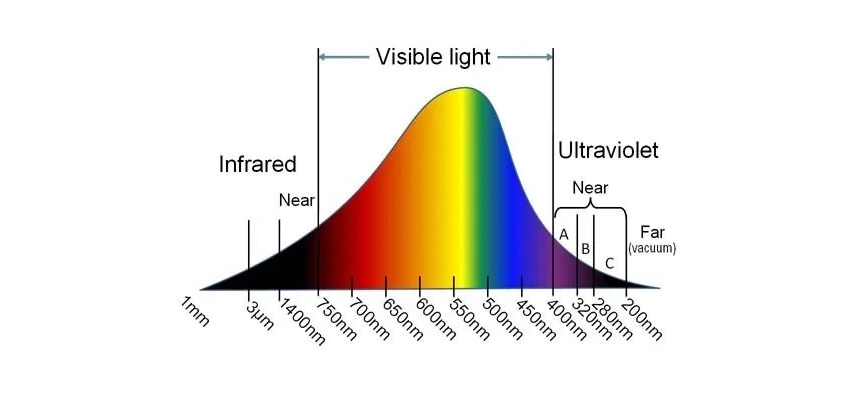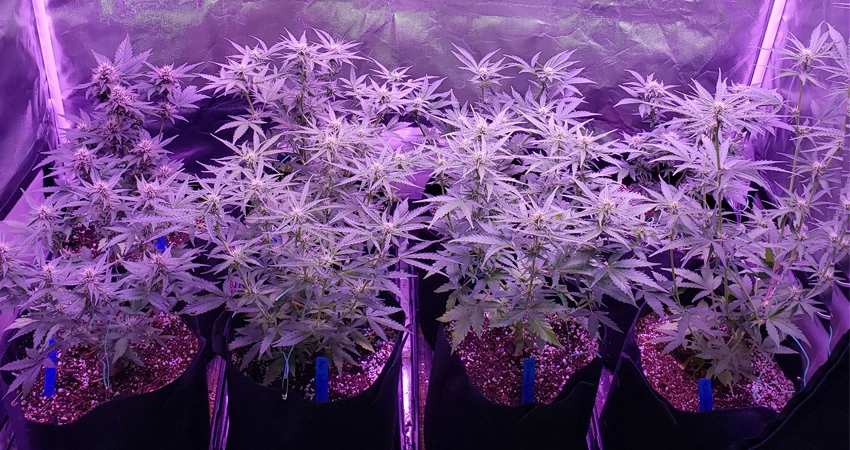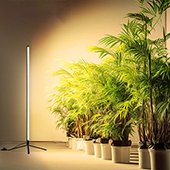Menu
Do Full Spectrum Grow Lights Emit UV?
Whether it’s rainy and overcast outside or the night is long, with LED plant lights, we can ensure that our indoor plants thrive and flourish, just like they do in summer. Especially with those advanced full spectrum LED grow lights, they act as magicians of sunlight for plants, mimicking all the colors of natural sunlight.
Full spectrum LED grow lights are high-tech lighting fixtures. They achieve this by employing carefully designed LED chip combinations, covering almost the entire spectrum of sunlight, from visible violet to red light, and even possibly extending into the invisible ultraviolet and infrared parts.
The purpose of doing so is to simulate natural sunlight conditions, ensuring that plants receive all the spectrum components they need for growth under any conditions.
However, there’s a question that many people may be concerned about: Do these full spectrum LED grow lights emit UV? After all, UV light has complex dual effects on plants in nature—both beneficial and detrimental.
Let’s delve into the world of full-spectrum LED plant lights together and explore this intriguing topic!
Table of Contents
Spectrum and Plant Growth
Let’s talk about how the spectrum interacts with plants.
Light is a mixture of different colors, like a rainbow, where each color represents a specific wavelength of light. The spectrum can roughly be divided into three major segments: ultraviolet (UV) light, visible light, and infrared light.
Ultraviolet light, the segment invisible to our eyes, has wavelengths shorter than visible light and is like a superpower. It’s divided into three types: UV-C (short-wave ultraviolet), UV-B (mid-wave ultraviolet), and UV-A (long-wave ultraviolet).
Although humans may fear overexposure to sunlight due to potential skin damage, for plants, an appropriate amount of ultraviolet (UV) light is a double-edged sword.
On one hand, UV light can help plants synthesize crucial bioactive substances. For instance, it can stimulate plants to produce more chlorophyll and other pigments, which are essential for photosynthesis and disease resistance.
At the same time, UV light can also influence the morphological development of plants. Sometimes, it can make plants grow stronger, thicken their leaves, or make their colors more vibrant.
On the other hand, excessive ultraviolet (UV) light can be detrimental. It can damage plant leaves’ cellular structure and disrupt chlorophyll’s balance, similar to how prolonged exposure to intense sunlight can damage our skin.
Prolonged exposure to high levels of UV light can lead to issues such as thinner leaves, slow growth, reduced yield, and increased susceptibility to diseases in plants.
As for visible light and infrared light, they are equally crucial for plants. Visible light constitutes the colorful world we see and serves as the primary energy source for photosynthesis in plants. It is responsible for converting carbon dioxide and water into oxygen and nutrients.
Infrared light, on the other hand, contributes to the accumulation of heat in plants and facilitates certain physiological processes.
Therefore, the quality of the spectrum received plays a significant role in plant growth. Just as plants require a balanced diet of nutrients, they also need a rich and appropriate spectrum for nourishment.
When cultivating plants indoors, the use of full-spectrum LED grow lights aims to simulate natural lighting conditions, providing plants with the optimal growing environment.
Design Principle of Full Spectrum LED Plant Light
The sun acts as a natural color palette, emitting various colors of light that blend to form the white light we perceive. Full-spectrum LED grow lights aim to achieve the same effect using scientific technology.
LED lights are composed of different-colored light-emitting diodes (LEDs), with each color corresponding to a specific wavelength of light. Designers carefully select and combine LEDs of different wavelengths to work together, mimicking the continuity and integrity of the solar spectrum.
For instance, blue LEDs simulate the blue light portion of sunlight, which is particularly important for the growth of plant stems and leaves. Red LEDs mimic the red light portion, which is indispensable for photosynthesis and fruit ripening in plants.
Some LED grow lights also incorporate wavelengths of far-red light and ultraviolet (UV) light. Far-red light aids in plant elongation and reproduction, while moderate amounts of UV light, as mentioned earlier, can enhance plant resistance and pigment synthesis.
However, it’s important to note that more UV light isn’t necessarily better; it must be controlled within a moderate range to prevent harm to the plants.
Full-spectrum LED grow lights ensure that each wavelength of light positively impacts plant growth through a scientifically balanced combination. This maximally mimics natural sunlight conditions, aiding plants in thriving and remaining healthy indoors.

Do Full Spectrum Grow Lights Emit UV?
In the market, there are indeed some full-spectrum LED grow light products that claim to include ultraviolet (UV) light components, but many do not. It’s like buying a fruit basket – some baskets contain cherries along with apples and bananas, while others do not include cherries.
From a technical perspective, the design concept of full-spectrum LED grow lights aims to mimic sunlight as closely as possible, and sunlight does contain a certain proportion of ultraviolet (UV) light.
However, due to the complex effects of UV light on both plants and human beings, engineers need to strike a balance when designing such lighting fixtures. Additionally, this complexity contributes to the high cost of full spectrum LED grow lights.
In general, most full-spectrum LED grow lights do not intentionally include the UVC wavelength of ultraviolet light because its effects on plants are limited, and it can be harmful to the eyes and skin of humans.
However, moderate amounts of UVB and UVA wavelengths can be beneficial for the growth of certain plants, such as promoting the formation of certain plant pigments and enhancing resilience.
If a full-spectrum LED grow light does indeed feature ultraviolet functionality, it would typically incorporate lower-energy and less harmful UVB and UVA wavelengths.
Moreover, the output intensity would be strictly controlled to ensure that it meets the needs of plants without posing unnecessary risks to human health or the surrounding environment.
When you see a full-spectrum LED plant light boasting about its ultraviolet functionality, don’t worry, it doesn’t mean it will turn into a dangerous little sun. Instead, it means that the LED plant lighting manufacturers have carefully considered safety and practicality while providing a comprehensive spectrum of light.
UV LED Plant Light Application
Let’s talk about the practical effects and controversies surrounding the application of ultraviolet (UV) light in LED grow lights, using cannabis cultivation as an example.
The role of ultraviolet light in LED grow lights is like adding a “seasoning” to the mix. Proper exposure to UV-B radiation can encourage cannabis plants to produce more of these beneficial compounds, thereby enhancing their quality.
Research indicates that moderate levels of UV-B radiation can stimulate cannabis plants to produce more terpenes, which are one of the pharmacologically active components found in cannabis.
In addition, UV light can enhance the resistance to diseases and adaptability of cannabis plants, making the overall plant more robust, which may potentially increase the quality and yield of cannabis.
An experiment found that introducing UV-B radiation to cannabis plants during their growth phase led to an increase in THC (tetrahydrocannabinol) content, indicating that UV light optimized the medicinal value of cannabis to some extent.
However, if this “seasoning” is added excessively, the situation may not be pleasant. Excessive or inappropriate UV light wavelengths can also have significant negative effects on cannabis cultivation.
If the UV radiation is too intense or if the plants are exposed to unsuitable wavelengths for extended periods, it’s akin to getting sunburned from prolonged exposure to the sun. Cannabis plants may experience leaf damage, stunted growth, and reduced photosynthetic efficiency.
Furthermore, some types of UV radiation, such as UV-C, have extremely high energy levels that can directly damage the cell structure of cannabis plants, essentially burning the plants. The consequences of this could lead to decreased plant vitality, not only affecting yield but also making the plants more susceptible to disease attacks.
When choosing LED grow lights with UV functionality for cannabis or other plants, it’s crucial to maintain a balance. It’s essential to harness the benefits of UV light while avoiding the drawbacks of overexposure. This ensures that our plant friends can grow healthy and robustly.
That’s why many high-end full-spectrum grow lights implement precise control and safe design measures for the UV component.

Conclusions and Suggestions
After circling back to the main topic, the question of whether full-spectrum LED grow lights should include the ultraviolet (UV) spectrum isn’t a straightforward yes or no.
Scientifically speaking, moderate amounts of UV light indeed have positive effects on certain plants (such as the cannabis we mentioned earlier), promoting the production of specific compounds and enhancing plant resilience. However, this doesn’t imply that all plants require or can tolerate UV exposure.
The conclusion is this: Whether full-spectrum LED grow lights include ultraviolet (UV) wavelengths should depend on the specific plant species, growth stage, and cultivation goals.
If your target plant does indeed benefit from UV light, such as wanting to increase certain active ingredient levels in cannabis, then choosing an LED grow light with an appropriate amount of UV-B wavelengths can be considered.
For growers, here are suggestions:
Understand the requirements: Firstly, understand the specific needs of the plants you are growing regarding ultraviolet (UV) light. Refer to relevant literature or consult with professionals to determine the optimal spectrum configuration for your plants.
Choose the right product: When selecting LED grow lights, carefully review the product specifications to confirm whether they provide an appropriate and safe UV wavelength. Remember, not all plants require UV light, and more is not necessarily better. The key is appropriateness.
Safety first: Ensure that the selected LED grow lights are safe for both people and the environment. Avoid using UV-C wavelength ultraviolet light with excessively high energy, as it can pose potential risks to both humans and plants.
Adjustment as needed: As plants grow through different stages, it may be necessary to adjust the lighting scheme accordingly. Flexible utilize LED grow lights with adjustable features to provide the appropriate amount of ultraviolet light as needed at any given time.
Get in touch with us!
From custom light planning, to tailored quotes, and everything in between, our team of horticulture experts are always ready to assist.




